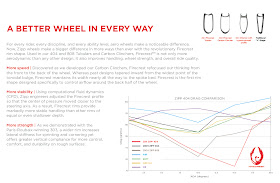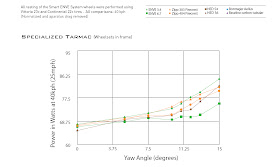The human brain loves to classify things. It loves to simplify everything into easily
definable, black and white categories.
Black and white is easy. Right
and wrong, good and evil, in or out—are all crutches for our brains to make
digesting complex ideas much simpler. The
problem is, life is rarely an issue of black and white. Our world operates on a much murkier
level.
Cycling is no exception.
The choices we make for what bike, wheels, shoes, or clothing are all
decisions that should be driven by context—who, what, when, and where you
are—but we, as consumers, constantly try to make these into objective
decisions. Manufacturers know this and
cater to it. They would be stupid not to—their
business model depends on convincing people that their product is best. The data that manufacturers present is not
necessarily incorrect—in fact it is almost always scientifically dependable,
but it is rarely put into any kind of context.
That is our responsibility.
A good bike shop will always help you take what industry marketing tells
you is scientific fact and put it in the appropriate context. It takes more fingers than I have to count
the brands that claim to have the fastest frame or wheelset on the market—and
pretty much everyone of them have some kind of data—wind tunnel testing or
otherwise—to support their claims. Your
easy black and white situation just turned to a certain shade of gray.
Let’s take a quick look at aero wheels. There is a myriad of data out there about
which wheel is fastest, and we won’t have to consider the even murkier area of
bike fit (which, by the way, should absolutely
be considered on a case by case basis, specific to each and every customer—be
leery of anyone who tells you they are selling the fastest bike available
without considering you as an individual first).
So to start our case study, I want you to go to any major
wheel manufacturers’ website and look for their wind tunnel data graph. They all have them. You will find something like this:
 | |
| From Zipp's website. |
Or this:
 | |
| From HED's website. |
Or This:
 |
| From ENVE Composites' website. |
So each of these manufacturers take this data and make the
same pitch to you: “Our wheels are faster than anyone else’s.” And in very specific situations, none of them
are wrong. Each of those graphs support
that claim. The thing about it is, they
aren’t really comparing apples to apples.
Each company controls their own testing—and I’m not trying to say they
don’t give honest results, but the conditions are different in every case.
Two of these graphs show the drag measured in grams, with no
mention of how fast the wheels were tested at, or whether they were on a bike
or by themselves. The other is very
specific about how the wheels were tested, but then converts the drag into
watts. Two graphs test to 20 degrees
yaw, while the other stops at 15 degrees.
The Hed data does not even include any competitors’ wheelsets. See where I’m going with this?
I’m not trying to say that these wheels are not tested correctly
or even that this data is incorrect or unreliable. I’m not even qualified to make those
claims. I’m certainly no expert in
aerodynamics or lab testing. I’m just
trying to say that there is more to the story than these graphs might
suggest.
A wheel that performs well in one frameset, may not in
another—and it may have been tested or developed without a frame around it at
all. A wheel that tests well at one angle
of yaw, may not fare as well as others in more of a crosswind. And so it goes. The list of variables here is lengthy.
So how do you go about choosing wheels? Well you need to do some soul searching I
suppose. Ask yourself those really
difficult questions. What kind of rider
am I? What am I looking for my wheels to
be good at? What kind of bike do I ride? Am I big or little? Then seek out the data that illuminates these
questions.
For example, a triathlete who is 5’2” and weighs 97 lbs should
look for a wheel that performs well in crosswinds because of the lack of
stability of aero bars and his or her small stature. A small climbing road cyclist, on the other
hand, will want a light and responsive aero wheel that does well on hills. You get where I’m going here.
The great news for everybody in this story, is that you have
a wealth of expertise in these types of questions at your fingertips—and I’m
not talking about Google. Find a local
independent bike shop that you trust and support them. These exact situations are what give these
shops their value. We deal with these
exact questions on a daily basis and have a wealth of experience in getting
people matched with the correct equipment.
That is something you just can’t get from a website.
Computers, science, the internet—they are good at black and
white. They will give you all the objective
information you need about the latest and greatest. But people—specifically people that you trust—are
better when trying to decipher your own certain shade of gray.






No comments:
Post a Comment